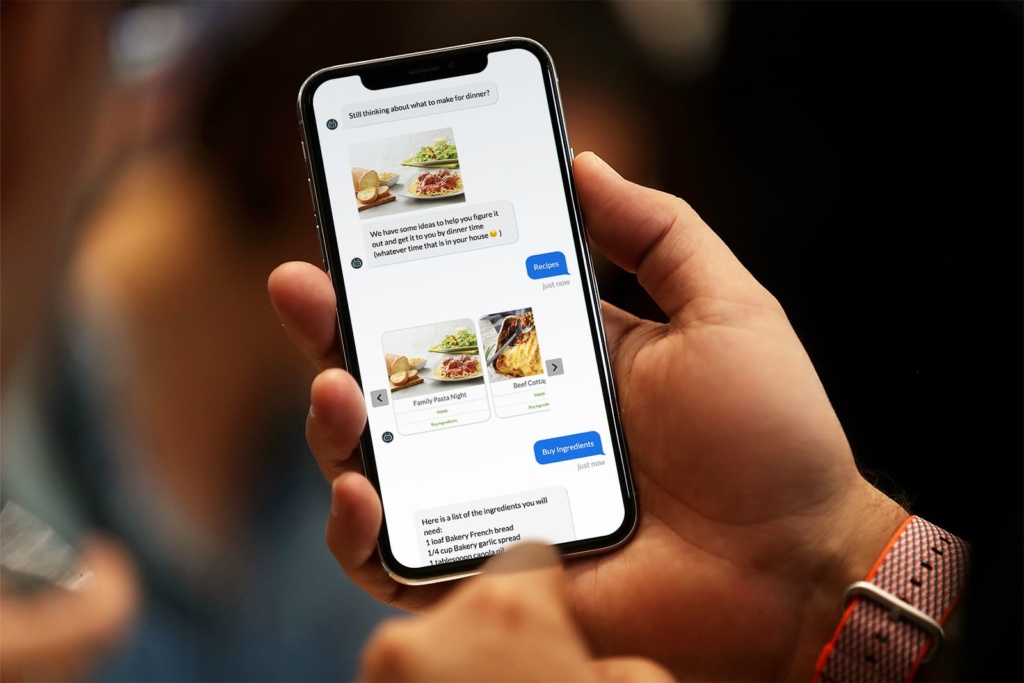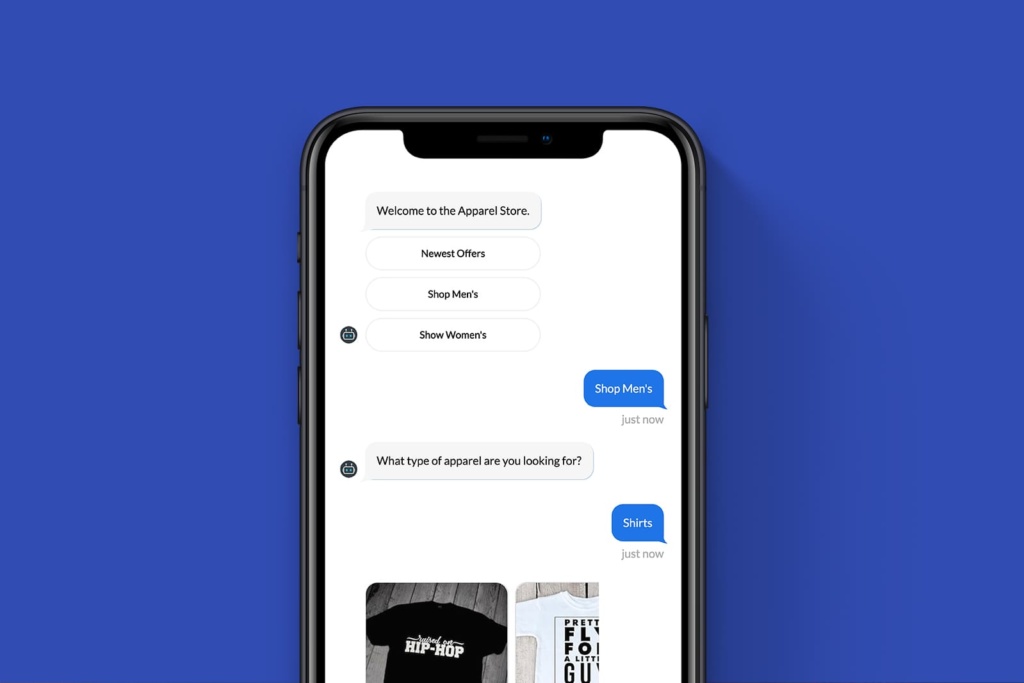Picture this: you’re working and it’s lunchtime. You pull up Slack and chat with tacobot to order tacos for your team. Tacobot takes your order and makes suggestions for added toppings and substitutions.
That’s conversational commerce – bringing messaging apps and shopping together.
Conversational commerce is the new frontier for chatbots.
Michael Lamb, President of nativeMsg
Conversational commerce uses SMS/MMS and messaging apps such as Facebook Messenger. Consumers get help by directly chatting with company representatives. More importantly, they can seamlessly click to purchase from within messaging apps. Consumers get what they need when they need it, and brands have increased selling opportunities. It’s a win, win.
What is the future of conversational commerce and how can your brand be a part of it? We’ve identified 4 important questions you may have about conversational commerce and the opportunities for your brand. But first, let’s look at the current business messaging landscape and how it works.

The Business Messaging Landscape
More and more, consumers are using messaging apps as a one-on-one communication vehicle over social media. This trend in communication has led to businesses hoping on board to meet consumers where they are with services and products. In a recent survey performed by Twilio, 66% of consumers stated they prefer to interact with brands through messaging apps.
66% prefer to interact with brands through messaging apps
Facebook dominates in the social and messaging space with two of its properties capturing the majority of users, WhatsApp and Facebook Messenger. WeChat, owned by a Chinese tech company, rounds out the top three in the messaging space in popularity with users.
How are the big three leveraging their audiences and using their platforms?
WhatsApp launched, WhatsApp for Business where businesses can actively message consumers who are already using the tool for communication.
Businesses such as 1-800-flowers and Uber, are using Facebook Messenger to reach customers in the app with their services. WeChat has integrated payment capabilities with messaging which has made the app a go-to resource for Chinese citizens to do everything from schedule doctor’s appointments to pay bills.
The two big tech giants, Apple and Google, are also using the messaging space for conservational commerce. Apple’s Business Chat gives businesses the ability to message iPhone and iMessage users. And Google has adopted RCS Business Messaging and offers it on Android. Google aims to leverage Android’s expansive user-base to adopt the service as a universal messaging upgrade from SMS.
So, how can your business incorporate conversational commerce into your marketing and customer engagement strategy?
Disconnected Message Spaces & API’s
The current global messaging space is disconnected. WhatsApp and Facebook Messenger are the leaders in North and South America among other countries. WeChat and smaller players, Telegram and Viper, are popular in China, Japan, and Russia.
There’s also no universal API that easily supports transmission, data security, and universal features. Each rich messaging platform has its RCS API. The current space is complex and that can make it frustrating for businesses who want one simple solution.
Right now, it falls on the business’ dime to disseminate the rapid partnering, between customer engagement platforms, providers and big tech, to determine the best entry point for capturing the most engagement. Or, just go sign up for all of it, which isn’t easy in execution or for operational resources.
It can be very overwhelming and expensive. Fortunately, there are solutions to this problem.
#1 How Do We Scale Conversational Commerce in the Current E- commerce Environment?
Do you need to be in all these messaging spaces to be successful? Simply put, yes. And you can be in all messaging channels easily with Conversational Media – that’s the beauty of it. The more touchpoints a consumer has with a brand across multiple channels, the stickier the brand and more likely customers are to do business with that brand and remain loyal.
62% of consumers said they would repeat business with a brand that responded to their questions in messaging channels.
Current technology has made it possible for brands to be in all the channels consumers are, answering their questions and delivering consistent brand messaging.
The best way to approach the question of scaling is to take an inventory of your current marketing efforts, technology, and workflows. To scale in any industry, no matter the technology, it’s helpful to ask yourself these questions:
- Do we have a central, shared hub for all market-driven data?
- Does our marketing metric KPIs effectively prove the return of investment?
- Have we structured marketing and workflows as best practice methods and strategies for our brand? In other words, can efforts be replicated?
Centralizing data access for all departments encourages ease in both growth and scaling. With so many marketing channels, touchpoints and measurability apps, measuring ROI can prove to be challenging. The best approach is to focus on the top business goal and track the metric that best fits.
Awareness, conversion, lead-build, and engagement are all parts of the whole overarching marketing strategy. When these foundational components are in place, you can clarify and address opportunities in messaging channels.
#2 How Can Businesses Move Forward Successfully (with Conversational Commerce)?
Determine how a platform can grow with your business needs, what partnership leading platforms are currently pursuing, and how engagement platforms plan to adapt to the new messaging space.
Consumers want to interact with real humans. A report done by Capgemini found 63% of consumers are increasingly satisfied with conversation commerce AI, yet they want more human-like interactions. Are your current platforms providing a human-like experience for your customers?
Deploying conversational logic (also referred to as conversational commerce AI) element within multiple messaging spaces can humanize the experience for your customers. 80% of companies are investing in an omnichannel experience (PWC 2020 survey). No matter which platform you choose, engagement on social messaging channels is readily feasible with Conversational Media.

#3 How Can Brands Leverage Conversational Commerce?
While you can access several bot-builder apps on Facebook Messenger, brands and enterprise businesses require a platform that will integrate with their marketing stack. Conversational Media platforms deploy conversational logic across channels from Slack to Facebook Messenger. Conversational AI can even enable voice assistance technology within messaging.
Think of the opportunities social media currently provides businesses to market their brand. Every messaging platform has the same type of selling opportunities. Your business should factor-in paid advertising within messaging and start thinking about the ways to harness rich media to create a superior customer experience.
With conversational commerce, your business has the opportunity to engage with customers in a personal way, provide real-time customer service, and assist customers in an instant. Your company can use the data to draw powerful business insights and make better business decisions.
Most brands are just waking up to how they can leverage conversational commerce to increase sales, improve customer satisfaction, and gain better insights. Conversational commerce is the future of e-commerce.
#4 How will Conversational Commerce Grow my Brand?
Conversational commerce fits into your overall marketing strategy for building brand awareness and increasing conversions. This gives brands direct access to customers and customers have direct access to brands. Businesses can send a consistent message to potential and existing customers across channels.
Conversational commerce can be customized with a brand’s colors and logo. When a consistent message and branding are deployed across multiple channels, you’ve got the consumer’s attention.
This technology helps brands to build awareness and reach consumers. Brands can learn from customer interactions, which help provide a better product, service, and overall customer experience.
This experience can easily blend the conversational commerce bot with live customer service support to serve as concierge, answer questions and make suggestions, It’s also capable of providing enhanced customer experience with natural language for things like processing orders, sending shipping updates or reminders.

The Future of Conversational Commerce
The future of conversational commerce is exciting. Conversational commerce has so much potential for both brands and consumers. Brands can create a more human-like, personal experience for consumers and grow their brand at the same time. The ease of use and fast response times leave customers more satisfied and brand loyal. Conversational commerce is here and it’s just the beginning.
Subscribe to our Newsletter
Free Trial
Get Started With RCS
Business Messaging!
Unlock the power of RCS and revolutionize your customer engagement.



